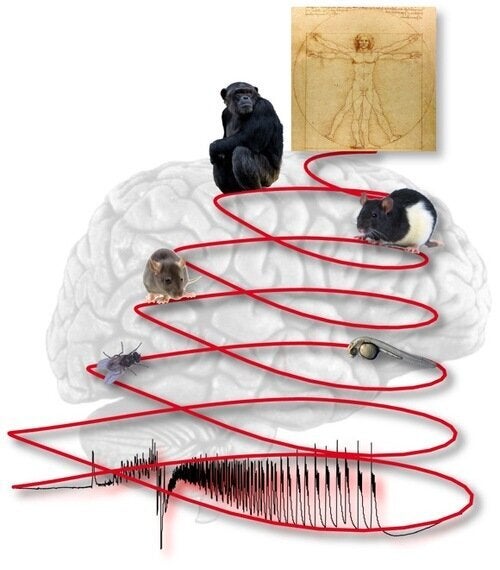Take home message. Scientists at the System Neuroscience Institute - Inserm U1106 in Marseille, France and the University of Michigan, USA have shown that epileptic seizures are a primitive form of brain activity common to all species, from flies to Humans. Such activity is always there - potentially - in any healthy brain. Epileptic seizures are coded (or hardwired) in our neuronal networks. They exist in a latent state.

Legend. Geometrically speaking, a seizure is a spiral travelling on a cone. The mathematical rules governing its onset and offset are invariant across species.
Epilepsy is the most frequent neurological disorder after migraine. It affects 1-2% of the world population. Thirty percent of patients with epilepsy are resistant to treatments. But what is a seizure? This question has been an enigma for patients, their relatives, researchers, and doctors for centuries. Epilepsy remains stigmatized, because seizures often occur without warning and with terrifying and embarrassing clinical symptoms. Scientists face similar emotions due to the complexities and technological limitations that accompany epilepsy research--seizures are still poorly understood and cure rates have not improved in over 50 years. But having unknown mechanisms does not necessarily mean seizures are complex.
Scientists at the System Neuroscience Institute - Inserm U1106 in Marseille, France and the University of Michigan, USA, have made a major breakthrough in our understanding of seizure mechanisms. The study has been published in the scientific journal Brain (Jirsa et al., On the nature of seizure dynamics, Brain, 2014). This work was partly supported by the CURE Foundation. Scientists combined theoretical neuroscience, experimental and clinical research to demonstrate that the principles governing onset, time course and offset of focal seizures are simple and invariant across brain regions and species, from flies to humans. This research represents a paradigm shift in epilepsy research: investigating how a seizure begins and ends, rather than the behavior during the seizure itself. They found that there are a limited number of ways a brain can transition into and out of a seizure. The work also suggests that a seizure can be induced in any "healthy" brain- that seizures exist in a latent state in all brains. This information formed the basis of a seizure classification scheme, a mathematical description that may help clinicians treat particular seizure types.
Metaphorically speaking, one can imagine brain activity as a boat floating down a river. There are many uncertainties in the exact path the boat takes, but in general it follows a certain flow. There are different branches and pathways to take moving down the river, representing different types of activities the brain can engage in (for example, reading a book, riding a bicycle, sleeping etc.). However, at many locations of this river there are swirling whirlpools or eddy currrents where the boat would not follow its normal flow but instead get stuck in one place, representing seizures. The river has barriers in place to protect the boat from entering the whirlpools, and so the only way to get stuck is if the boat is forcibly pushed over the barrier, or if the barrier breaks down. The whirlpools are always there, but the boat normally avoids them completely.
The research team produced a mathematical model that describes the pathway from the time when the boat enters the whirlpool (seizure onset) until it leaves (seizure offset), to go back to a normal activity. They found that the trajectories to enter and exit the seizure zone obey simple and precise mathematical rules. In fact, seizures may be one of the simplest (or primitive) forms of activity that the brain can produce. They verified this prediction experimentally by showing that the same rules of seizure onset and offset were present across different brain regions, causes of seizures, and species as diverse as flies, zebrafish, rats, monkeys, and humans.
Thus, the same seizure "whirlpools" exist in all forms of focal epilepsy tested. Rather than seizures being a special case or mysterious phenomenon, this work suggests that seizures are naturally coded within all healthy brain circuits and follow defined rules.
So what happens in patients with epilepsy?
For seizures to occur spontaneously, or for the boat to reach the whirlpool, the barrier must break down. There are many physiological situations that can weaken the barrier: it decays naturally during aging, or is not yet strong enough in infants, and thus seizures are more common in both infants and the elderly. Diseases such as autism, Alzheimer's, encephalitis, stroke, head trauma, and brain tumors all disrupt the barrier by reorganizing brain circuitry, and are all associated with seizures. The list of potential causes is extensive and diverse, but remarkably the seizure dynamics are always similar. This leads back to the example of the boat on the river: the path travelled or the mechanism of eroding the barrier do not matter--the whirlpool is always the same. The pathological conditions just reveal an activity that is already present in a latent state in everyone.
Why is it difficult to treat epilepsy?
The ability to create seizures via many different pathways may explain why epilepsy is difficult to treat. Epilepsy treatments have been focused on the seizure itself, the activity that is common to all patients regardless of the underlying cause. This broad-spectrum approach has been mostly effective, as these treatments work in about two-thirds of all patients. But for those patients who do not respond to medicine, this work suggests a different approach: to treat the underlying cause that disrupted the barrier, stopping the brain from ever entering the "seizure whirlpool". This method would have to be tailored to individual patients, as the pathway and the type of disruption can take many different forms.
In all, this work constitutes a major breakthrough in epilepsy research, demystifying epilepsy, providing a conceptual framework to understand seizure mechanisms, and proposing new strategies for therapy.
So, what is epilepsy? One answer is that seizures simply reflect an activity naturally coded in our brain. Thus, epilepsy should not be stigmatized.